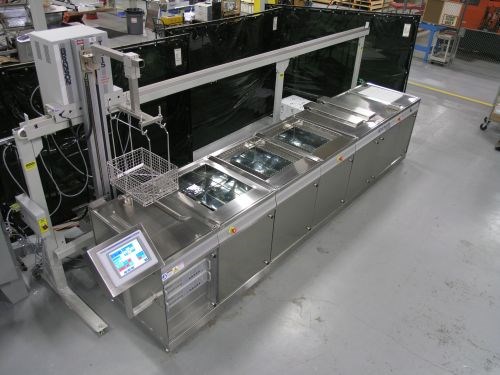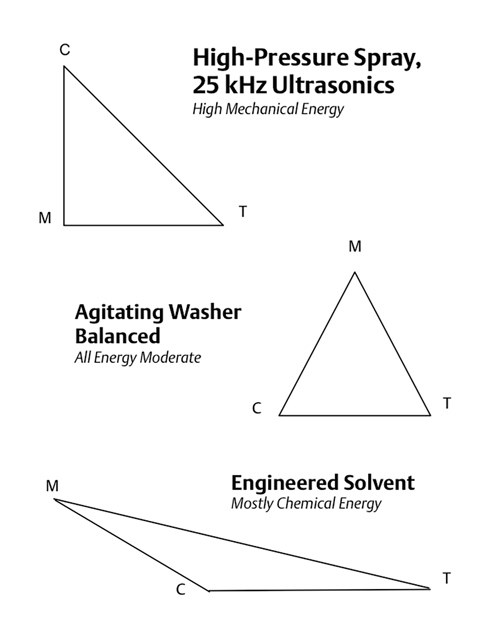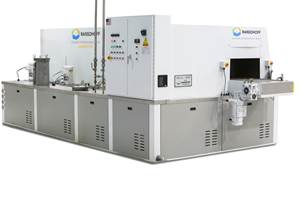The Process and Equipment Relationship
Anyone charged with the responsibility of implementing a cleaning step within their manufacturing operation should understand the interrelationship between the cleaning process itself and the cleaning equipment.
Anyone charged with the responsibility of implementing a cleaning step within their manufacturing operation should understand the interrelationship between the cleaning process itself and the cleaning equipment. The two are very different entities, yet form a necessary symbiotic relationship. If either component fails to perform, the entire operation fails. An engineer might assume that a standard cleaning system configuration will get the job done, only to be disappointed that it doesn’t meet his expectations. It must be understood that the process cleans the parts, and the equipment delivers that process; the two elements cannot perform independently of one another.
Cleaning is merely filling and draining or wetting and evacuating the surface of a part. Whether the process is aqueous or solvent, the active mechanisms involve wetting the target surface with chemistry, acting upon that surface, and then evacuating the by-product of this interaction.
The cleaning objective must first be identified, followed by the development of a process that meets this objective repeatedly, reliably and consistently. Without an effective process, there is little need for equipment. Conversely, if this process cannot be delivered and implemented by equipment, it is of little use as well.
The science/art comes into play while determining when, how often, and what to fill or wet with, the actions that will be taken while it is filled, and how to evacuate the resulting soil. Measurement of the cleanliness achieved would be ideal; the result has been verified by lab scale testing. This data defines the process. The balance of the operation depends upon the equipment to deliver these prescribed process parameters.
The now mature concept of the Cleaning Triangle, with its temporal and energy components, more precisely defines the process. Chemical, thermal and mechanical energies, along with exposure time to this set of parameters, constitutes the cleaning process itself. Chemical and thermal aspects are chosen depending on the scope of the work to be performed. A given cleaning compound may be employed to condition the soil for easier removal. An alternate compound might be used to both address the oil and then serve to modify a metal surface (cleaning and finishing in one process step). The addition of mechanical energy serves to not only accelerate the interaction, but can also serve as a process delivery mechanism (agitation/flushing to liberate entrapped air).
Passive
Proper part orientation is essential for passive process delivery. Optimal part orientation allows filling/draining with no workload manipulation or any external mechanisms. Gravity is an important component, along with the influence of attractive forces interacting to facilitate filling/draining. Immersing a vertically oriented piece of pipe is a good example, as filling and draining occur freely.
In cases where part geometry calls for fill/drain on various axes, workload manipulation needs to be employed (rotation, tipping, agitation, and so on) to overcome the physical behaviors that keep air entrapped or liquids in place. Although the workload is actively manipulated, the process is still highly dependent on the passive mechanisms.
Workload manipulation is frequently used to passively deliver processes and differs from active process delivery by serving to present the parts to the process. Batch processing in a rack or basket requires manipulation of the entire workload as a whole.
Active
Individual workpiece handling provides flexibility where the actual process can be precisely delivered to specific areas of the part. This is called active process delivery. It serves to deliver the process directly to the parts. It exploits and overcomes the elements associated with passive delivery. An example is a horizontal piece of pipe flushed out with the pressure of a garden hose.
With individual part flow, the process acts directly upon the part’s fixed orientation, rather than a batch workload merely subjected to the process. Active displacement of entrapped air can take place through flushing mechanisms. Likewise, active evacuation can be used to flush out soils as well as blow out rinse water. Pressurized air could be the sole drying mechanism, or a blowout followed by hot forced air for final drying. The part moves in a linear fashion through these precisely delivered process mechanisms.
A hybrid scheme would move a batch of racked parts through the process. An example is a conveyorized spray or immersion washer. Properly oriented parts would travel through the various process zones (wash, rinse, dry). The equipment delivers the process to the entire workload, but not as precisely as if parts were handled individually. Focusing process on the critical areas of an individual part would typically be more efficient than blanketing a larger batch footprint. The cleaning objective and the desired material handling will combine to create what the machine/process will ultimately look like.
Interdependence
The equipment must deliver, maintain and support these established process parameters to achieve a reliable and repeatable cleaning objective. A cleaning system can have multifaceted functions. Transport of the workloads through the process/machine, as well as process maintenance are only two of these. Examples of equipment process maintenance include cleaning compound concentration monitoring/control; rinse water quality monitoring/control; wash tank oil removal; an outboard reflux still; filtration monitoring/control; and data acquisition in support of statistical process control. The equipment must maintain the process, and they must work together.
The manufacturing engineer must have a good understanding of the process mechanisms that precede design of an equipment configuration, and attention to detail is necessary. Is process delivery precise enough? An application may require flushing to actively fill a part, but the flushing mechanism must also target the area of the part that needs to be evacuated. On the other hand, a simple spray may suffice. Cost, complexity and performance are factors to consider.
Shortcuts can exist where a mature application/equipment configuration might permit skipping the process development stage, but the result still must be proven. A properly designed spray washer that cleans plumbing fittings will most likely be able to clean other similar geometry parts. An ultrasonic system that cleans orthopedic implants might also be effective with newly designed implants.
Regardless of this perceived overlapping utility, minor part geometry differences can be enough to modify these tried-and-true machine designs.
Looking Forward
Flexibility in the process brings distinct advantages with respect to equipment design. A process may be proven for a particular application, but it’s best if it can also be effective with part design changes or future adjustments in upstream manufacturing activity. Does the relocation of a blind hole present complications while filling/draining a part? Does an increase in production rate impose undue stress on a machine’s ability to remove oil from a wash tank? Changes such as moving from oil-based to water-based machining fluids can have a profound effect, so potential production process modifications need to be considered.
Related Content
Tips for Cleaning Oily Parts
Degreasers are the best option for cleaning parts machined with oil. Vacuum degreasers are recommended for cleaning complex parts.
Read MoreSita’s CleanoSpector Measures Part Cleanliness
PMTS 2023: Handheld measuring device checks for cleanliness of parts to assure product quality as well as prior to follow-up processes.
Read MoreCorrosion Prevention: How to Avoid the Enemy of Metal Parts
This chemical reaction that is a constant, indiscriminate and costly enemy of metal parts is preventable, but intentional measures must be taken and become an essential process within a company’s walls.
Read MorePMTS 2023 Product Preview: Parts Cleaning
Learn about some of the latest parts cleaning solutions that will be on display at PMTS 2023.
Read MoreRead Next
Seeing Automated Workpiece Measurement in Real Time
User-friendly inspection software for CNC machining centers was shown at IMTS 2024 monitoring measurements between and after machining while performing SPC based on recorded measurement values.
Read MoreDo You Have Single Points of Failure?
Plans need to be in place before a catastrophic event occurs.
Read MoreA Tooling Workshop Worth a Visit
Marubeni Citizen-Cincom’s tooling and accessory workshop offers a chance to learn more about ancillary devices that can boost machining efficiency and capability.
Read More
























